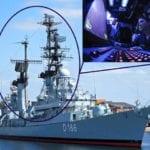Narrower Planes, Broader Aircraft Connector Markets
As the aircraft market shifts towards smaller planes, advanced cockpit and infotainment features call for connectors that can fly high.
The commercial aircraft industry has had a couple of slow years, but growth is expected to return with a shift. Now, smaller aircraft are leading the market. This evolution should herald solid growth for connector makers who can provide the right mix of speed, reliability, and ruggedness, as well as those who provide components for the infotainment systems today’s buyers demand.
Persistence Market Research predicts that the commercial aircraft market will see growth of 4.1% from 2017 to 2022, while the wide-body aircraft that led the market earlier in the decade will see a CAGR of only 3.5% in the same time period. The narrow-body category of aircraft is designed to carry smaller numbers of travelers between hub cities.
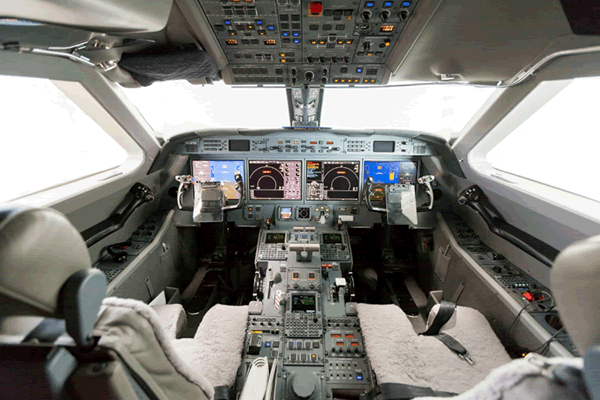
Glass cockpits are driving increased demand for connectors.
Although they are comparatively small, narrow-body aircraft are equipped with a full array of electronics, including the latest navigation systems. Recent trends that favor glass cockpits also increase demand for connectivity products. Glass cockpits feature digital, LED-lit instrument displays, instead of traditional analog dials and gauges. In the passenger area of the plane, modern infotainment systems are also creating growing demand for electronics. Aircraft equipment designers now work closely with connector suppliers to ensure that efficient and effective components are available to meet the demands of these systems. Traditional aircraft connector requirements, including resistance to vibration, shock, temperature changes, and pressure, are still in play. Other critical requirements for aircraft include small form factor and reduced weight. Now, however, connectors must also support high speeds and large amounts of data.
Engineering departments in the aircraft design department are becoming more directly involved in each component’s capability, as well as the potential for expanded performance,” said Bob Stanton, technology director at Omnetics. “Circuit speeds are increasing with high-speed digital electronics. This also saves space and weight but puts pressure on older aircraft connector suppliers to establish miniature and microminiature products for this industry.”
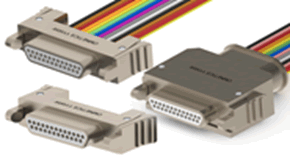
Omnetics’ Micro-D connectors provide high-reliability performance ideal for aerospace applications.
Customer demand for infotainment is a primary driver for many changes as well. Consumers who are connected in their homes, offices, and vehicles often want to enjoy the same environment when they’re flying.
“Streaming from plane-to-ground or plane-to-satellite for in-flight entertainment continues to improve,” said Chuck Grantz, mil/aero sales manager at Samtec. “Put another way, our customers are trying to duplicate in their aircraft all of the services and connectivity found at home or in the workplace. This includes faster and uninterrupted signaling to accomplish these improvements.”
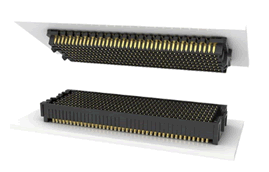
Samtec’s Searay™ connectors help aerospace engineers add functionality.
Meeting consumer requirements while providing the reliability and durability needed by airlines and private owners is not easy, especially given the long lifetimes of aircraft, and is prompting a growing focus on designing connectors that meet strict performance requirements.
“Industry leaders in commercial aircraft are using more military/defense requirements,” Grantz said. “For example, commercial customers often necessitate connectors that meet stricter shock and vibration requirements than in years past.”
Fulfilling these military requirements demands close attention to detail. Connector makers are responding by using proven technologies that combine to provide reliable electrical and mechanical performance.
“The spring-pin and socket system has proven reliability over wide ranges of shock, vibration, and thermal changes,” Stanton said. “Made of beryllium copper with high tensile strength (17,200ksi), it manages to withstand the rigors of use and abuse often experienced in service. Pin and socket elements selected should also pass plating tests specified in ASTM B488 type II, Code C class 1.27,w hich requires a strong nickel-plate barrier that is then coated with 50 micro-inches of gold.”
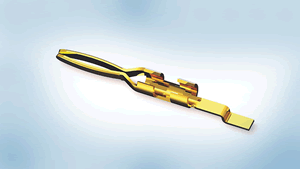
Gold plating over beryllium copper provides reliability and performance. (Source: Omnetics)
Many styles of connectors can be used to meet different requirements throughout aircraft. But sometimes, the cables attached to them will vary, depending on the speed of the signals.
“High-data-rate cable assemblies offer customers tremendous design flexibility to utilize a wide variety of connector interfaces in a high-speed cabling application,” Grantz said. “This includes a choice of micro coax or twinax cables.”
The requirements may change over the lifetime of the aircraft, which often encompasses several decades. So, cable and connector system must be designed to adapt to evolving trends, as equipment is replaced on varying timeframes.
[quote]Our customers are trying to duplicate in their aircraft all of the services and connectivity found at home or in the workplace. This includes faster and uninterrupted signaling to accomplish these improvements.[/quote]
Many factors will change as systems are upgraded. For instance, the rapid ascent of signal speeds is continuing unabated, forcing connector makers to constantly find ways to increase frequencies while working within size and weight restrictions.
“We are seeing more next-gen customer redesigns that require higher-speed, higher-bandwidth, and higher-density interconnect systems,” Grantz said. “What are currently 1–6GHz connectors are heading to anywhere from 10.3–28GHz.”
Aerospace designers are also moving to combine power and data in the same package. Discrete connectors are seeing less usage as clever engineers devise ways to ensure that crosstalk, EMC, and other issues don’t occur.
“Power supplies for plug-in equipment are combined with high-speed digital signal pins to handle signal transmission,” Stanton said. “This conversion from two cables to one combo cable saves time, cost, space, and weight. The key to these customizations is that connector designers are using solid modeling to construct 3D connectors sized to fit into the aircraft compartments while offering software routing design for the cable inside the module.”
Recently posted:
[related_posts limit=”10″]
- State of the Industry: 2022-2023 Connector Sales - April 16, 2024
- Amphenol is On a Roll - April 2, 2024
- Nicomatic Proves That Two Heads are Better Than One - March 26, 2024




